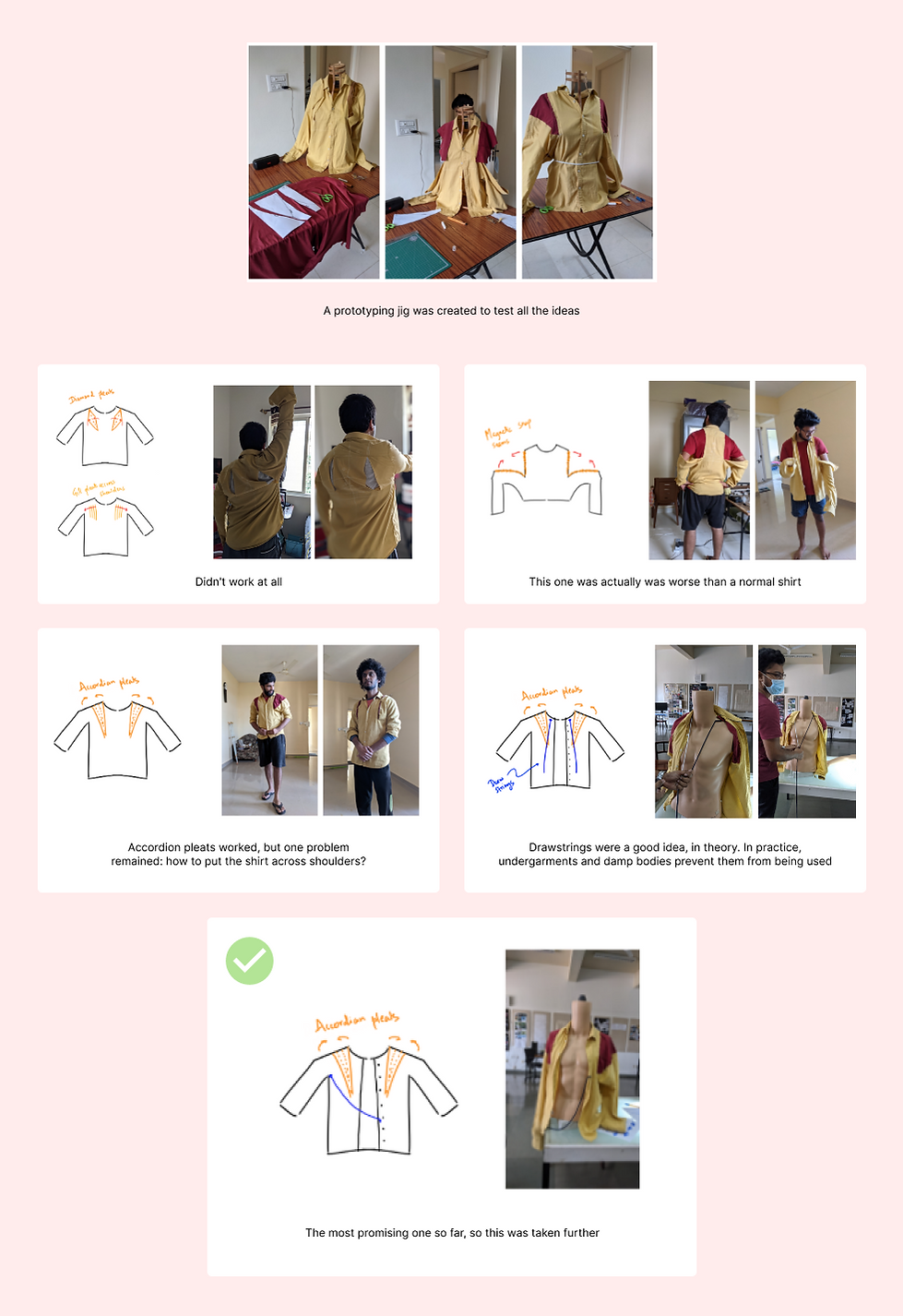
Put on, Take off
As part of a classroom project on "Everyday Inconveniences", this project evolved from simplifying wearing jackets to resolving the experience of wearing apparel for people with limited shoulder mobility.
The challenge, in typical Universal Design parlance, can we make wearing shirts easier for men with restricted shoulder movement, keeping in mind the dignity, fashion choices, and ergonomics?
Duration: 6 weeks | Classroom project
Validating the premise
I pulled statistics and spoke to people
-
~10 lakh cases of frozen shoulder are diagnosed every year in India. Shoulder movement is restricted for a period of one to three years
-
Rotator cuff injuries are common, and after surgery, shoulders remain stiff for the recovery period
-
In each case, people have to adjust to a new style of wearing loose-fitting or stretchable clothing. This changes the expression of style and the confidence that comes from wearing clothes that you love
-
As a secondary use case, specialized equipment like racing suits could be made easier to wear
So...how to do it?
It's a clothing project, so studying how self-expression and confidence is tied to the clothes you wear was an important consideration.
Because I do not come from an apparel design or textile background, I had to familiarise myself with the basics of apparel design, mechanics of the upper limbs, fabrics, and pattern making. Here is the rough project plan that I followed

Contextual Inquiry
I started off by observing the dressing routines of someone with a shoulder injury and compared them with that of a normal person. The major problem comes in putting the shirt across the shoulder, not putting the arm through the sleeves as I had originally expected

A study of Jackets & fashion choices on personal confidence
This was done to familiarise myself with anything similar that had been done in the past, and how clothing has a positive impact on self-confidence. While the study was on jackets, the findings could be extended to all kinds of front opening apparel.

Market Research & Competitor Analysis
To identify products currently available and find problems (if any) that needed to be addressed by the solution.

Expert advice & interviews
I also spoke to doctors about Adhesive Capsulitis (Frozen Shoulder) and rotator cuff injuries, their effects on daily life, what parts of the movement are affected, and what is the recovery regimen of patients.
Since a certain amount of movement of the shoulder was recommended as a part of the recovery process, the solution could in fact promote a certain amount of shoulder movement during dressing.

Personas
Throughout the above research, two primary types of personas seemed to emerge.


Research Summary
The following project parameters were inferred from the research.

Ideation
An ideation map that took through different prototyping options. Highlighted the ones that seemed worth trying.

Prototyping
I created a prototyping jig using an old shirt to test different concepts and to evaluate their performace.

Here is the last prototype being tested with promising results in studio settings

Feedback and Re-iteration
After testing the prototype in the field, a pattern, or rather, an insight emerged. One could make wearing shirts easier by simply rethinking hw people find shoulder holes




Prototyping Synthesis
Through my research I arrived at three separate approaches, each of them solving the problem with different levels of intervention at the garment and the dressing area. Fewer modifications to the garment meant more hardware in the dressing area, and vice versa.
Since fashion is a very personal choice, and conjecture from my interactions with the users, it was decided that little modification on the garment was acceptable.





References
-
A Comprehensive Guide to The Importance of Functionality in Clothing for Wheelchair Users and People Living with Physical Disabilities. (n.d.). IZ Adaptive. Retrieved 5 July 2022, from https://izadaptive.com/blogs/posts/functionality-in-clothing-for-wheelchair-users
-
Chromat Ted Talk. (n.d.). CHROMAT. Retrieved 5 July 2022, from https://chromat.co/blogs/news/chromat-ted-talk
-
Frozen shoulder—Symptoms and causes—Mayo Clinic. (n.d.). Retrieved 5 July 2022, from https://www.mayoclinic.org/diseases-conditions/frozen-shoulder/symptoms-causes/syc-20372684
-
How to Get Dressed and Undressed After Shoulder Surgery or Injury—YouTube. (n.d.). Retrieved 5 July 2022, from https://www.youtube.com/watch?time_continue=531&v=ptai8849h_I&feature=emb_logo
-
Iberall, A. S. (1964). The Use of Lines of Nonextension to Improve Mobility in Full-pressure Suits. Aerospace Medical Research Laboratories.
-
Kerala Shirt | Move Ability. (n.d.). Retrieved 5 July 2022, from https://moveability.in/en/product/kerala-shirt/
-
Magnetic Zipper—Patent Pending—Say Goodbye to Zipper—YouTube. (n.d.). Retrieved 5 July 2022, from https://www.youtube.com/watch?v=ENmGibiy7X0&t=1s
-
Men’s Short Sleeve Adaptive Shirts—Silverts. (n.d.). Retrieved 5 July 2022, from https://www.silverts.com/men-s-short-sleeve-adaptive-shirts
-
One simple move to loosen up your shoulders—Sequence Wiz. (n.d.). Retrieved 5 July 2022, from https://sequencewiz.org/2016/03/16/loosen-up-your-shoulders/
-
Pinterest. (n.d.). Pinterest. Retrieved 5 July 2022, from https://in.pinterest.com/sprshv/jackets/
-
Planet Earth Shirt | Green edition | Vollebak. (n.d.). Retrieved 5 July 2022, from https://www.vollebak.com/product/planet-earth-shirt-green/
-
Precision Wellbeing Group. (2020, May 10). Understanding FROZEN SHOULDER and how to stretch for greater movement. https://www.youtube.com/watch?v=DzSwJHdP8ek
-
Site Maintenance. (n.d.). Retrieved 5 July 2022, from https://aaraamse.in/
-
Super Fly Jacket 30sec—YouTube. (n.d.). Retrieved 5 July 2022, from https://www.youtube.com/watch?v=xT5eiNGGmFI
-
Tommy Adaptive | Tommy Hilfiger USA. (n.d.). Retrieved 5 July 2022, from https://usa.tommy.com/en/tommy-adaptive
-
YKK® VISLON® Zipper Magnet Type—YouTube. (n.d.). Retrieved 5 July 2022, from https://www.youtube.com/watch?v=ojDQJ0l9pIE
-
Zappos Adaptive | Zappos.com. (n.d.). Retrieved 5 July 2022, from https://www.zappos.com/e/adaptive
